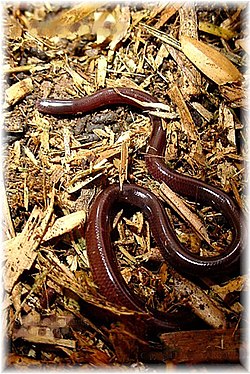Evolution
Despite only having fossils as early as the Cretaceous, Scolecophidia itself likely originated in the Middle Jurassic, with Anomalepididae, Leptotyphlopidae, and Typhlopoidea diverging from one another during the Late Jurassic. Within Typhlopoidea, Gerrhopilidae likely diverged from the Xenotyphlopidae-Typhlopidae clade during the Early Cretaceous, and Xenotyphlopidae and Typhlopidae likely diverged from one another during the Late Cretaceous. [9]
Scolecophidians are believed to have originated on Gondwana, with anomalepidids and leptotyphlopids evolving in west Gondwana (South America and Africa) and the Typhlopoidea (typhlopids, gerrhopilids, and xenotyphlopids) on east Gondwana, initially on the combined India/Madagascar land mass, during the Mesozoic. [9] Typhlopids, initially isolated on Madagascar, then dispersed to Africa and Eurasia. South American typhlopids appear to have evolved from African typhlopids that rafted across the Atlantic about 60 million years ago; they, in turn, dispersed to the Caribbean about 33 million years ago. [9] Similarly, typhlopids appear to have reached Australia from Southeast Asia or Indonesia about 28 million years ago. [9] Meanwhile, the gerrhopilids, isolated on Insular India, underwent a radiation throughout tropical Asia following the collision of India with Asia, while the xenotyphlopids remained isolated on Madagascar. [11]
The Malagasy typhlopoids ( Madatyphlops in Typhlopidae and Xenotyphlops in Xenotyphlopidae) are among the only extant terrestrial vertebrates on Madagascar whose isolation occurred due to vicariance from the Cretaceous breakup of Gondwana. The only other terrestrial vertebrate on Madagascar that shares this evolutionary history is the Madagascan big-headed turtle (Erymnochelys madagascariensis); all other Malagasy land vertebrates dispersed from the mainland to an already-isolated Madagascar from the latest Cretaceous to the present. [11]

